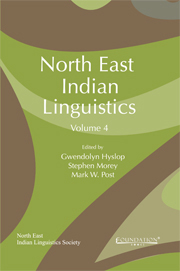Book contents
- Frontmatter
- Contents
- About the Contributors
- Foreword
- A Note from the Editors
- History, Contact and Evolution
- 1 On the Origins of Bodo-Garo
- 2 The Stammbaum of Boro-Garo
- 3 Variation in the Order of Modification in Tai Ahom: An Indication of Historical Boro-Garo Influence?
- 4 The Nominalizing Velar Prefix *gV- in Tibeto-Burman Languages of Northeast India
- Bodo-Garo Grammar
- Orthography, Poetics and Text
- New Descriptions
- Classifiers
- Eastern Indo-Aryan Grammar
- Austroasiatic
4 - The Nominalizing Velar Prefix *gV- in Tibeto-Burman Languages of Northeast India
from History, Contact and Evolution
Published online by Cambridge University Press: 05 May 2013
- Frontmatter
- Contents
- About the Contributors
- Foreword
- A Note from the Editors
- History, Contact and Evolution
- 1 On the Origins of Bodo-Garo
- 2 The Stammbaum of Boro-Garo
- 3 Variation in the Order of Modification in Tai Ahom: An Indication of Historical Boro-Garo Influence?
- 4 The Nominalizing Velar Prefix *gV- in Tibeto-Burman Languages of Northeast India
- Bodo-Garo Grammar
- Orthography, Poetics and Text
- New Descriptions
- Classifiers
- Eastern Indo-Aryan Grammar
- Austroasiatic
Summary
Introduction
The goal of this article is to document data of nominalizing velar prefixes found in Tibeto-Burman (TB) languages of different branches spoken in Northeast India (NEI).
These data include and expand data sets on a Proto-Tibeto-Burman (PTB) “adjectival velar prefix” presented by Wolfenden (1929), Shafer (1966), Benedict (1972), and Matisoff (2003). This long-known velar prefix has been shown to occur on adjectival and stative verbs in different branches of Tibeto-Burman, and therefore was reconstructed with this function for PTB.
The additional evidence presented here reveals other functions of the “adjectival prefix” in most of the languages. Based on a growing body of literature on nominalization in TB, we know that these other functions are typically associated with nominalization, as is derivation of adjectives.
Specifically, the literature on nominalization in TB documents derivational functions on the one hand, i.e. deriving action/event and agent/patient nouns from verbs, and the derivation of adnominal modifiers as well as the marking of (verbal) citation forms. On the other hand, we find clausal nominalization typically associated with subordinate clauses (relative, complement, and, less commonly, adverbial clauses) as well as with particular main clause constructions (focus and emphatic constructions, questions, aspect marking, etc.) which sometimes get reanalyzed as new default constructions (see Bickel 1999, DeLancey 1989; 1994; in press, Genetti et al 2008, Noonan 1997, inter alia).
- Type
- Chapter
- Information
- North East Indian Linguistics , pp. 58 - 80Publisher: Foundation BooksPrint publication year: 2012
- 2
- Cited by



